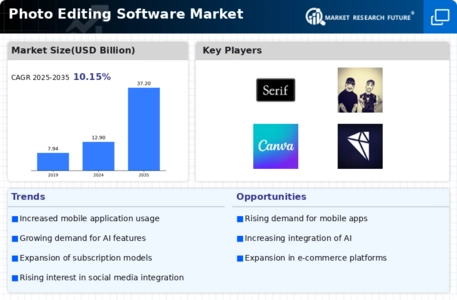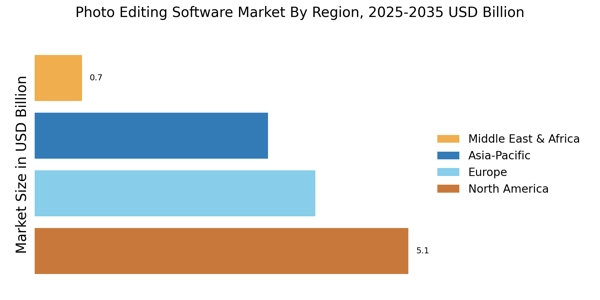The Photo Editing Software Market is currently characterized by a dynamic competitive landscape, driven by rapid technological advancements and evolving consumer preferences. Key players such as Adobe (US), Corel (CA), and Canva (AU) are at the forefront, each adopting distinct strategies to enhance their market positioning. Adobe (US) continues to leverage its strong brand equity and extensive product suite, focusing on innovation through regular updates and feature enhancements. Corel (CA), on the other hand, emphasizes affordability and user-friendliness, appealing to a broader audience, while Canva (AU) has carved a niche by integrating design tools with social media functionalities, thus enhancing user engagement and accessibility.
The competitive structure of the market appears moderately fragmented, with numerous players vying for market share. This fragmentation is indicative of diverse consumer needs, prompting companies to adopt localized strategies and optimize their supply chains. The collective influence of these key players shapes the market dynamics, as they continuously adapt to technological changes and consumer demands, fostering a competitive yet collaborative environment.
In August 2025, Adobe (US) announced the launch of its new AI-driven editing tool, which aims to streamline the photo editing process by automating complex tasks. This strategic move not only reinforces Adobe's commitment to innovation but also positions it to capture a larger share of the market by appealing to both professional and amateur photographers seeking efficiency. The integration of AI technology is likely to enhance user experience and set a new standard in the industry.
In September 2025, Corel (CA) unveiled a partnership with a leading online education platform to offer tutorials and courses on photo editing. This initiative is strategically significant as it not only promotes Corel's products but also educates potential users, thereby expanding its customer base. By investing in user education, Corel is likely to foster brand loyalty and encourage long-term usage of its software.
In July 2025, Canva (AU) expanded its functionalities by introducing a collaborative editing feature, allowing multiple users to work on a project simultaneously. This development is particularly relevant in the context of remote work and digital collaboration trends. By enhancing its platform's collaborative capabilities, Canva positions itself as a leader in the market, catering to the needs of teams and organizations that require efficient and effective design solutions.
As of October 2025, the Photo Editing Software Market is witnessing trends such as increased digitalization, sustainability initiatives, and the integration of artificial intelligence. Strategic alliances among companies are becoming more prevalent, as they seek to leverage each other's strengths to enhance product offerings and market reach. Looking ahead, competitive differentiation is likely to evolve, shifting from price-based competition to a focus on innovation, technological advancements, and supply chain reliability. Companies that can effectively harness these trends will likely emerge as leaders in this rapidly changing landscape.


















Leave a Comment